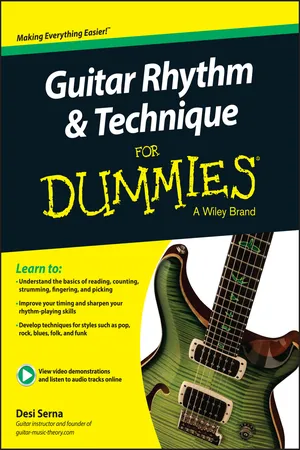![]()
Part I
Getting Started with Guitar Rhythm and Technique
For Dummies can help you get started with lots of subjects. Visit
www.dummies.com to learn more and do more with
For Dummies. In this part . . .
- Find out how to use a metronome as a pacesetter and to develop rock-solid timing.
- Get to know the most basic parts of the music staff so that you can find your way around a lead sheet.
- Work with note values, rests, and time signatures to play strum patterns and develop your rhythm-guitar skills.
![]()
Chapter 1
Rhythm and Technique in a Nutshell
In This Chapter
Getting an overview of rhythm and technique
Access the audio tracks and video clips at
www.dummies.com/go/guitarrhythmtechniqueIn this chapter, I explain why it’s beneficial for you to develop your sense of rhythm and sharpen your technique. I also give you an overview of the different topics you explore as you work through this book. When you have an idea of what the whole program is about, you have a clearer picture of the road that lies ahead.
Recognizing the Importance of Rhythm and Technique
Every aspect of guitar playing requires some level of skill. As much as you might like to jump straight to playing familiar songs by your favorite bands and improvising like your favorite guitarists, the truth is that you need to work on developing your technique before you can achieve success on your instrument. Sure, you can pick up on things here and there as you go, but if you’re serious about getting good, why not take a more purposeful approach, one that produces better results in a shorter amount of time? The progress of many guitarists is hindered not because they lack the ability to play well, but because they don’t follow the steps necessary to progress. How can you sound as good as the next person when the next person has learned tips and tricks that you haven’t yet been introduced to?
All guitarists, regardless of style, make use of the same basic techniques. How much you use a particular technique, or how far you take it, is a matter of preference and part of what defines your sound and style.
You can get a taste of what rhythm and technique is all about by watching Video Clip 1 and listening to Audio Track 1.
Reading and Playing Basic Rhythms
Your journey to improving your guitar playing starts with a look at rhythms. Rhythm is the time in which you sound notes. It affects the feel and groove of everything you play. Developing your rhythm doesn’t require you to read music like a concert violinist, but it’s helpful to get to know the basic components of a staff and how music is rhythmically notated, which is precisely what Chapter 2 focuses on. This information will not only help you to improve your strumming, but also prepare you to read the slash notation commonly used in performance charts.
Developing Your Strumming Technique
In this book, you work with some aspects of standard notation strictly as a means to improve your guitar playing. Seeing how measures of music are subdivided, counted, and strummed will take the guesswork out of your rhythm playing and help you get your pickstrokes in order.
Aside from dissecting the strum patterns used in popular music, you work with developing essential rhythm guitar skills such as floating, resting, damping, scratching, and accenting. These techniques contribute to the feel and sound of a rhythm part and help you to develop a strong groove whether you’re playing folky acoustic guitar songs, electric rock rhythms, or funky chord comps. Various rhythms, strum patterns, and strumming techniques are covered in Chapters 3, 4, and 5.
Honing Your Fretting-Hand Techniques
There is far more to the left hand (or the right hand if you’re a lefty) than simply fretting notes on the fretboard. Guitarists use fretting-hand fingers to hammer into notes as well as pull off, slide, and bend. These techniques, called articulations, help you execute passages, produce unique sounds, and be more expressive. In order to advance as a player and be successful as a musician, you need to develop these performance skills and know how they’re notated in a guitar score. You work with articulations at length in Chapter 7.
In addition to developing technique, you also need to know how to play to your strengths. Perhaps some of your struggles are caused by a belief that there are “proper” and “correct” ways that things should be played on guitar. The truth is, your hands don’t work in exactly the same way as someone else’s hands, and sometimes you need to explore unconventional ways to fret and finger chord shapes and scale patterns in order to find what best suits you. You get started with this process in Chapter 6.
Honing Your Picking-Hand Techniques
There is far more to the right hand (or the left hand if you’re a lefty) than simply brushing the strings. To reach any level of proficiency with guitar, you need to develop the techniques of picking with a flatpick (also known as a plectrum) and plucking with the fingers.
Skilled players alternate their picks, synchronize their hands, cleanly sound notes, and mute idle strings — all at the same time. When you break down the mechanics of picking alone, you see that various means of picking exist — including alternate, sweep, economy, inside, outside, cross, and hybrid (all techniques covered in Ch...






